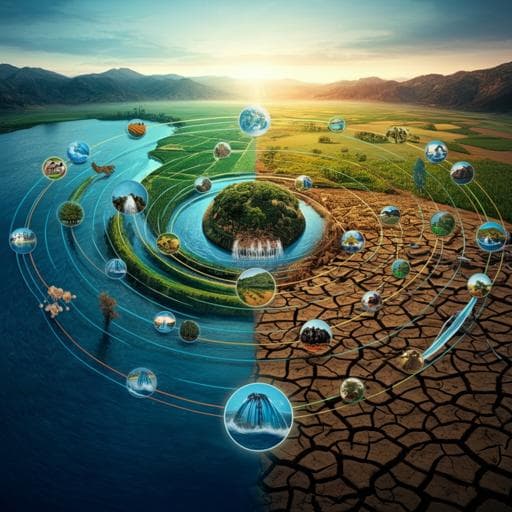
Environmental Studies and Forestry
Competition for water induced by transnational land acquisitions for agriculture
D. D. Chiarelli, P. D'odorico, et al.
This study reveals how transnational large-scale land acquisitions can strain local water resources through increased irrigation and the cultivation of water-intensive crops. Conducted by renowned researchers including Davide Danilo Chiarelli and Paolo D'Odorico, it highlights the critical issue of water scarcity exacerbated by industrial agriculture.
~3 min • Beginner • English
Introduction
The study investigates whether transnational large-scale land acquisitions (LSLAs) for agriculture target locations with advantageous hydrological conditions and whether such investments create competition over water with existing local users. Water, unlike other resources, is difficult to transport and its use is local, making control of land with access to rainwater, rivers, or aquifers a common pathway to appropriating water. Given rapid expansion of LSLAs since 2005 and their promotion as drivers of rural development, the authors question if these deals intensify water use through irrigation and shift to water-intensive crops, thereby exacerbating blue water scarcity and rival uses. The purpose is to quantify pre-existing and induced green, blue, and economic water scarcity associated with LSLAs, to assess investor targeting of hydrologically favorable land, and to evaluate implications for local water security and competition.
Literature Review
Prior work shows water is a major determinant of LSLAs and that investors may consume large volumes of blue water for export-oriented cash crops. Studies have quantified blue water needs for individual deals and assessed green/blue water demand in Africa, but a comprehensive assessment of how LSLAs alter local water scarcity and competition has been lacking. Literature also discusses the concept of agricultural economic water scarcity where water exists but infrastructure is lacking, and debates whether investments could close yield gaps through irrigation. The authors build on global datasets of land deals (Land Matrix), crop water modeling (e.g., WATNEEDS), and water scarcity frameworks distinguishing green, blue, and economic scarcity, addressing gaps by linking LSLAs to targeting of freshwater access and quantifying resultant competition for water across scenarios.
Methodology
Study sample: 160 georeferenced foreign LSLAs (197 locations) >200 ha, intended for agriculture, contracted/in startup/in production after 2000, with transfer of rights to foreign commercial users and reliable coordinates, drawn from Land Matrix. Deals span 4.1 Mha across 39 countries (mostly Africa) and were approximated spatially as discs centered at provided coordinates with deal-reported area. Intended uses include food (58%), nonfood/unspecified (38%), biofuels (17%), timber plantations (11%), and livestock (12). Deal years mostly 2008–2012.
Scenarios: (1) Before acquisition: pre-deal cultivation and crops. (2) Current use: current cropped area; commercial sub-areas assumed to grow intended crops and be irrigated; remaining area follows pre-deal crops/practices. (3) 100% cultivated: full deal area cultivated with intended crops and fully irrigated where needed (no economic water scarcity assumed).
Crop cover: Pre-deal crop coverage from GlobCover 2005 (300 m). Current cropped/non-cropped from GFSAD30 (30 m), aggregated to 300 m and harmonized to correct GlobCover biases via proportionality constants (per Müller et al.).
Irrigation infrastructure: Presence/absence of center pivot irrigation visually assessed using Google Earth Pro time-series for each deal (images circa 2000 and most recent, typically 2019–2020), to detect changes.
Crop-water modeling: WATNEEDS soil water balance with Penman–Monteith ET to estimate green and blue water consumption and irrigation requirements under non-stressed conditions. Crop-specific rainfed/irrigated areas (MIRCA2000) scaled to pre-deal remote-sensed crop cover. Intended crops from Land Matrix allocated equally when multiple reported. Climate parameters averaged over 2011–2015. Crop coefficients and calendars primarily from Siebert et al.; supplementary parameters from Chapagain et al. Tree plantations (eucalyptus, rubber) set to 0 blue water (assumed rarely irrigated).
Water scarcity assessment: Following Rosa et al., green water scarcity occurs when rainfall supplies <90% of crop water requirements. Monthly blue water scarcity computed by comparing total consumptive uses (agriculture from WATNEEDS, plus domestic/industrial from Hoekstra and Mekonnen, 5×5 arc-min) to available blue water (PCR-GLOBWB2 blue flows 2011–2015 minus environmental flow). Environmental flows set to 80% of natural monthly blue water flow, thus unavailable for human use. Upstream consumption and routing considered to affect downstream availability. Losses due to irrigation inefficiency excluded from consumption (they return to system). Agricultural economic water scarcity identified on croplands not equipped for irrigation, experiencing water deficits but no blue water scarcity.
Targeting analysis: Targeting ratios compare each deal’s attributes to national cropland averages: distance to rivers (Grill et al.; rivers with upstream catchment ≥1000 km², sensitivity tested), groundwater table depth (Fan et al.), and green water scarcity (months during growing seasons). Ratios <1 imply preferential targeting of more favorable conditions (e.g., shallower groundwater, closer rivers).
Case studies: Two Ethiopian deals (~15,000 ha each) in Oromya (Omo basin) and Gambella (Nile tributary) with intended crops maize, sugarcane, cotton, sunflower. Modeled flow propagation using HydroSheds directions and WATNEEDS to assess downstream impacts on monthly water scarcity.
Uncertainty: Potential misreporting/speculative deals; uncertainty in actual crops and irrigation extent; assumption of full irrigation in scenarios may overestimate use, though only consumptive blue water counted; tree blue water set to zero; storage (dams/reservoirs) not represented; groundwater depletion dynamics not assessed; recommend groundwater monitoring in deals.
Key Findings
- Investors preferentially target hydrologically favorable land: deals are on croplands with shallower-than-average water tables and shorter-than-average distances to rivers, and with lower-than-average green water scarcity compared to national cropland averages. In >50% of deals (85/160), the closest river flows through the acquired land.
- Before acquisition: Of >4 Mha contracted, ~825,000 ha (~20%) were harvested pre-deal (3.1% irrigated). Of cultivated area: 16% had no green water scarcity; 14% had green water scarcity but no blue water scarcity (sustainable irrigation possible); the remaining 70% faced blue water scarcity, implying potential competition if irrigated. Blue water used pre-deal was 0.045 km³ y−1 (mainly rice 27%, coffee 9%, sugarcane 8%, maize 7%, wheat 6%). Additional 1.5 km³ y−1 would be needed to close yield gaps where green water is scarce.
- Current use: Cultivated areas expanded to 26% of acquired land (2000–2015). Irrigated areas under blue water scarcity increased ~15-fold to 0.18 Mha across 53 locations, consuming 0.5 km³ y−1. If all currently cropped land were irrigated, area under blue water scarcity would reach 0.8 Mha in 88 locations (45% of sample), predominantly in Africa. In 64 cases, irrigation expansion likely increased production without compromising local water availability; pivot irrigation verified in 10 of these. In 88 blue water-scarce locations, investor irrigation likely induced competition; pivots verified in 53 of these.
- Exacerbation cases: In 23 cases (~168,000 ha), LSLAs are exacerbating blue water scarcity conditions under current use.
- 100% cultivated scenario: Fully expanding intended crops and irrigation would require 8.1 km³ y−1 of consumptive blue water (Africa ~5.6 km³ y−1). Blue water scarcity would affect 2.7 Mha across 105 locations (67% of acquired area; 54% of deals), indicating broad competition with local users and environmental flows. Only 47 locations (5% of acquired area) have sufficient blue water for sustainable expansion. Estimated blue water withdrawals would be 27.7 km³ y−1 under current national-average efficiencies and 10.9 km³ y−1 assuming 75% sprinkler efficiency.
- Role of crop shifts: Cultivating pre-deal crops over 100% area would need 5.6 km³ y−1, ~30% less than with intended crops, showing crop transitions to more water-demanding cash crops drive additional scarcity. Additional blue water demand contributions: oil palm + sugarcane ~40%, maize 12%, soybean 9%, wheat 9%.
- Downstream impacts (Ethiopia case studies): During dry season, upstream LSLA irrigation increased downstream water scarcity by >10% over ~23,000 ha and ~2,300 ha of cultivated land, respectively, in the worst month (December/January), constraining future downstream irrigation opportunities and affecting pastoralist communities.
- Overall, LSLAs substantially contribute to irrigation infrastructure expansion and increased blue water demand, often resulting in rival and potentially inequitable water use with local farmers and ecosystems.
Discussion
Findings indicate that LSLAs commonly target land with superior access to blue water (rivers and shallow groundwater) and lower rainfed risk, effectively reallocating hydrologically advantageous areas from local users to commercial agriculture. The expansion of irrigated cultivation and shifts toward water-intensive, export-oriented crops substantially increase consumptive blue water use, frequently in basins already experiencing blue water scarcity. Consequently, irrigation by LSLAs induces rival water use conditions, heightening competition with nearby and downstream farmers and encroaching on environmental flow needs. While some investments alleviate agricultural economic water scarcity by providing infrastructure where blue water is ample, the majority of cases exacerbate blue water scarcity, threatening local food security, rural livelihoods, and ecosystems, and exporting virtual water benefits away from local communities. Downstream propagation of scarcity underscores basin-scale consequences; adaptive responses by downstream users could further compound unsustainable withdrawals. Overall, the results challenge narratives that LSLAs broadly and sustainably close yield gaps via irrigation, instead highlighting risks of water appropriation and “water grabbing.”
Conclusion
The paper demonstrates that transnational LSLAs frequently appropriate blue water resources by targeting hydrologically favorable lands and expanding irrigated, water-intensive crops, thereby exacerbating blue water scarcity and competition with local users in most cases. Only a small fraction of deals could sustainably expand irrigation. Policy implications include the need for governance frameworks that explicitly address water allocation, environmental flow protection, and principles of water justice in land investment processes. Future research and policy actions should incorporate routine monitoring of groundwater, consideration of storage operations and timing, improved transparency on actual crop choices and irrigation practices within deals, and basin-scale assessments of cumulative downstream impacts to ensure that agricultural development does not undermine local water security and ecosystem integrity.
Limitations
Key uncertainties include: potential misreporting or speculative deals; discrepancies between intended and actual land use and crop types; uncertain extent of irrigation—scenarios assume full irrigation of cultivated/acquired areas which may overestimate use, though only consumptive blue water is counted; tree plantation blue water set to zero (conservative); absence of explicit modeling of surface water storage (dams/reservoirs) and its temporal buffering; groundwater sourcing and depletion risks not assessed due to data limitations. Visual detection of irrigation pivots may miss non-pivot systems. Despite these limitations, results likely understate broader water impacts (e.g., water quality, access, fisheries).
Related Publications
Explore these studies to deepen your understanding of the subject.







